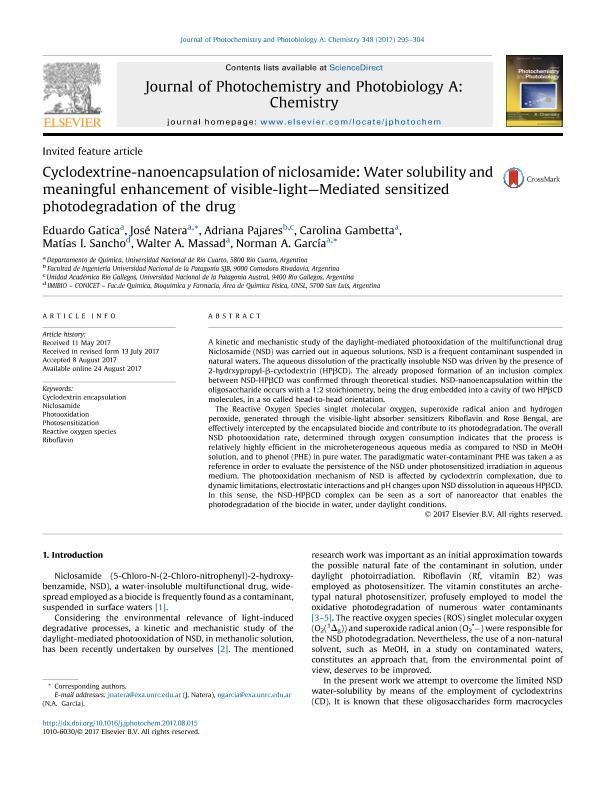Artículo
Cyclodextrine-nanoencapsulation of niclosamide: Water solubility and meaningful enhancement of visible-light—Mediated sensitized photodegradation of the drug
Gatica, Eduardo Antonio; Natera, Jose Eduardo ; Pajares, Adriana Mabel
; Pajares, Adriana Mabel ; Gambetta, Carolina
; Gambetta, Carolina ; Sancho, Matias Israel
; Sancho, Matias Israel ; Massad, Walter Alfredo
; Massad, Walter Alfredo ; Garcia, Norman Andino
; Garcia, Norman Andino
 ; Pajares, Adriana Mabel
; Pajares, Adriana Mabel ; Gambetta, Carolina
; Gambetta, Carolina ; Sancho, Matias Israel
; Sancho, Matias Israel ; Massad, Walter Alfredo
; Massad, Walter Alfredo ; Garcia, Norman Andino
; Garcia, Norman Andino
Fecha de publicación:
11/2017
Editorial:
Elsevier Science Sa
Revista:
Journal of Photochemistry and Photobiology A: Chemistry
ISSN:
1010-6030
Idioma:
Inglés
Tipo de recurso:
Artículo publicado
Clasificación temática:
Resumen
A kinetic and mechanistic study of the daylight-mediated photooxidation of the multifunctional drug Niclosamide (NSD) was carried out in aqueous solutions. NSD is a frequent contaminant suspended in natural waters. The aqueous dissolution of the practically insoluble NSD was driven by the presence of 2-hydrxypropyl-β-cyclodextrin (HPβCD). The already proposed formation of an inclusion complex between NSD-HPβCD was confirmed through theoretical studies. NSD-nanoencapsulation within the oligosaccharide occurs with a 1:2 stoichiometry, being the drug embedded into a cavity of two HPβCD molecules, in a so called head-to-head orientation. The Reactive Oxygen Species singlet molecular oxygen, superoxide radical anion and hydrogen peroxide, generated through the visible-light absorber sensitizers Riboflavin and Rose Bengal, are effectively intercepted by the encapsulated biocide and contribute to its photodegradation. The overall NSD photooxidation rate, determined through oxygen consumption indicates that the process is relatively highly efficient in the microheterogeneous aqueous media as compared to NSD in MeOH solution, and to phenol (PHE) in pure water. The paradigmatic water-contaminant PHE was taken a as reference in order to evaluate the persistence of the NSD under photosensitized irradiation in aqueous medium. The photooxidation mechanism of NSD is affected by cyclodextrin complexation, due to dynamic limitations, electrostatic interactions and pH changes upon NSD dissolution in aqueous HPβCD. In this sense, the NSD-HPβCD complex can be seen as a sort of nanoreactor that enables the photodegradation of the biocide in water, under daylight conditions.
Archivos asociados
Licencia
Identificadores
Colecciones
Articulos(IMIBIO-SL)
Articulos de INST. MULTIDICIPLINARIO DE INV. BIO. DE SAN LUIS
Articulos de INST. MULTIDICIPLINARIO DE INV. BIO. DE SAN LUIS
Articulos(SEDE CENTRAL)
Articulos de SEDE CENTRAL
Articulos de SEDE CENTRAL
Citación
Gatica, Eduardo Antonio; Natera, Jose Eduardo; Pajares, Adriana Mabel; Gambetta, Carolina; Sancho, Matias Israel; et al.; Cyclodextrine-nanoencapsulation of niclosamide: Water solubility and meaningful enhancement of visible-light—Mediated sensitized photodegradation of the drug; Elsevier Science Sa; Journal of Photochemistry and Photobiology A: Chemistry; 348; 11-2017; 295-304
Compartir
Altmétricas



